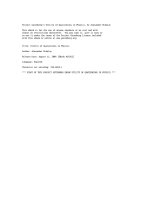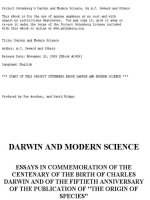Project Gutenberg’s History of Modern Mathematics, by David Eugene Smith pot
Bạn đang xem bản rút gọn của tài liệu. Xem và tải ngay bản đầy đủ của tài liệu tại đây (364.45 KB, 75 trang )
Project Gutenberg’s History of Modern Mathematics, by David Eugene Smith
Copyright laws are changing all over the world. Be sure to check the
copyright laws for your country before downloading or redistributing
this or any other Project Gutenberg eBook.
This header should be the first thing seen when viewing this Project
Gutenberg file. Please do not remove it. Do not change or edit the
header without written permission.
Please read the "legal small print," and other information about the
eBook and Project Gutenberg at the bottom of this file. Included is
important information about your specific rights and restrictions in
how the file may be used. You can also find out about how to make a
donation to Project Gutenberg, and how to get involved.
**Welcome To The World of Free Plain Vanilla Electronic Texts**
**eBooks Readable By Both Humans and By Computers, Since 1971**
*****These eBooks Were Prepared By Thousands of Volunteers!*****
Title: History of Modern Mathematics
Mathematical Monographs No. 1
Author: David Eugene Smith
Release Date: August, 2005 [EBook #8746]
[Yes, we are more than one year ahead of schedule]
[This file was first posted on August 9, 2003]
Edition: 10
Language: English
Character set encoding: ASCII / TeX
*** START OF THE PROJECT GUTENBERG EBOOK HISTORY OF MODERN MATHEMATICS ***
Produced by David Starner, John Hagerson,
and the Online Distributed Proofreading Team
i
MATHEMATICAL MONOGRAPHS
EDITED BY MANSFIELD MERRIMAN AND ROBERT S. WOODWARD
No. 1
HISTORY OF MODERN
MATHEMATICS.
BY
DAVID EUGENE SMITH,
PROFESSOR OF MATHEMATICS IN TEACHERS COLLEGE, COLUMBIA
UNIVERSITY.
FOURTH EDITION, ENLARGED.
1906
ii
MATHEMATICAL MONOGRAPHS.
edited by
Mansfield Merriman and Robert S. Woodward.
No. 1. HISTORY OF MODERN MATHEMATICS.
By David Eugene Smith.
No. 2. SYNTHETIC PROJECTIVE GEOMETRY.
By George Bruce Halsted.
No. 3. DETERMINANTS.
By Laenas Gifford Weld.
No. 4. HYPERBOLIC FUNCTIONS.
By James McMahon.
No. 5. HARMONIC FUNCTIONS.
By William E. Byerly.
No. 6. GRASSMANN’S SPACE ANALYSIS.
By Edward W. Hyde.
No. 7. PROBABILITY AND THEORY OF ERRORS.
By Robert S. Woodward.
No. 8. VECTOR ANALYSIS AND QUATERNIONS.
By Alexander Macfarlane.
No. 9. DIFFERENTIAL EQUATIONS.
By William Woolsey Johnson.
No. 10. THE SOLUTION OF EQUATIONS.
By Mansfield Merriman.
No. 11. FUNCTIONS OF A COMPLEX VARIABLE.
By Thomas S. Fiske.
EDITORS’ PREFACE.
The volume called Higher Mathematics, the first edition of which was published in 1896, contained eleven chapters by eleven authors, each chapter being
independent of the others, but all supposing the reader to have at least a mathematical training equivalent to that given in classical and engineering colleges.
The publication of that volume is now discontinued and the chapters are issued
in separate form. In these reissues it will generally be found that the monographs are enlarged by additional articles or appendices which either amplify
the former presentation or record recent advances. This plan of publication has
been arranged in order to meet the demand of teachers and the convenience
of classes, but it is also thought that it may prove advantageous to readers in
special lines of mathematical literature.
It is the intention of the publishers and editors to add other monographs to
the series from time to time, if the call for the same seems to warrant it. Among
the topics which are under consideration are those of elliptic functions, the theory of numbers, the group theory, the calculus of variations, and non-Euclidean
geometry; possibly also monographs on branches of astronomy, mechanics, and
mathematical physics may be included. It is the hope of the editors that this
form of publication may tend to promote mathematical study and research over
a wider field than that which the former volume has occupied.
December, 1905.
iii
AUTHOR’S PREFACE.
This little work was published about ten years ago as a chapter in Merriman and
Woodward’s Higher Mathematics. It was written before the numerous surveys
of the development of science in the past hundred years, which appeared at
the close of the nineteenth century, and it therefore had more reason for being
then than now, save as it can now call attention, to these later contributions.
The conditions under which it was published limited it to such a small compass
that it could do no more than present a list of the most prominent names in
connection with a few important topics. Since it is necessary to use the same
plates in this edition, simply adding a few new pages, the body of the work
remains substantially as it first appeared. The book therefore makes no claim
to being history, but stands simply as an outline of the prominent movements
in mathematics, presenting a few of the leading names, and calling attention to
some of the bibliography of the subject.
It need hardly be said that the field of mathematics is now so extensive
that no one can longer pretend to cover it, least of all the specialist in any one
department. Furthermore it takes a century or more to weigh men and their
discoveries, thus making the judgment of contemporaries often quite worthless.
In spite of these facts, however, it is hoped that these pages will serve a good
purpose by offering a point of departure to students desiring to investigate the
movements of the past hundred years. The bibliography in the foot-notes and
in Articles 19 and 20 will serve at least to open the door, and this in itself is a
sufficient excuse for a work of this nature.
Teachers College, Columbia University,
December, 1905.
iv
Contents
EDITORS’ PREFACE.
iii
AUTHOR’S PREFACE.
iv
1 INTRODUCTION.
1
2 THEORY OF NUMBERS.
4
3 IRRATIONAL AND TRANSCENDENT NUMBERS.
6
4 COMPLEX NUMBERS.
8
5 QUATERNIONS AND AUSDEHNUNGSLEHRE.
10
6 THEORY OF EQUATIONS.
12
7 SUBSTITUTIONS AND GROUPS.
16
8 DETERMINANTS.
18
9 QUANTICS.
20
10 CALCULUS.
23
11 DIFFERENTIAL EQUATIONS.
26
12 INFINITE SERIES.
30
13 THEORY OF FUNCTIONS.
33
14 PROBABILITIES AND LEAST SQUARES.
38
15 ANALYTIC GEOMETRY.
40
16 MODERN GEOMETRY.
45
17 ELEMENTARY GEOMETRY.
49
v
CONTENTS
vi
18 NON-EUCLIDEAN GEOMETRY.
51
BIBLIOGRAPHY.
54
GENERAL TENDENCIES.
59
PROJECT GUTENBERG ”SMALL PRINT”
62
Article 1
INTRODUCTION.
In considering the history of modern mathematics two questions at once arise:
(1) what limitations shall be placed upon the term Mathematics; (2) what force
shall be assigned to the word Modern? In other words, how shall Modern
Mathematics be defined?
In these pages the term Mathematics will be limited to the domain of pure
science. Questions of the applications of the various branches will be considered
only incidentally. Such great contributions as those of Newton in the realm
of mathematical physics, of Laplace in celestial mechanics, of Lagrange and
Cauchy in the wave theory, and of Poisson, Fourier, and Bessel in the theory of
heat, belong rather to the field of applications.
In particular, in the domain of numbers reference will be made to certain of
the contributions to the general theory, to the men who have placed the study of
irrational and transcendent numbers upon a scientific foundation, and to those
who have developed the modern theory of complex numbers and its elaboration
in the field of quaternions and Ausdehnungslehre. In the theory of equations
the names of some of the leading investigators will be mentioned, together with
a brief statement of the results which they secured. The impossibility of solving
the quintic will lead to a consideration of the names of the founders of the group
theory and of the doctrine of determinants. This phase of higher algebra will
be followed by the theory of forms, or quantics. The later development of the
calculus, leading to differential equations and the theory of functions, will complete the algebraic side, save for a brief reference to the theory of probabilities.
In the domain of geometry some of the contributors to the later development
of the analytic and synthetic fields will be mentioned, together with the most
noteworthy results of their labors. Had the author’s space not been so strictly
limited he would have given lists of those who have worked in other important
lines, but the topics considered have been thought to have the best right to
prominent place under any reasonable definition of Mathematics.
Modern Mathematics is a term by no means well defined. Algebra cannot
be called modern, and yet the theory of equations has received some of its most
important additions during the nineteenth century, while the theory of forms is a
1
ARTICLE 1. INTRODUCTION.
2
recent creation. Similarly with elementary geometry; the labors of Lobachevsky
and Bolyai during the second quarter of the century threw a new light upon the
whole subject, and more recently the study of the triangle has added another
chapter to the theory. Thus the history of modern mathematics must also be
the modern history of ancient branches, while subjects which seem the product
of late generations have root in other centuries than the present.
How unsatisfactory must be so brief a sketch may be inferred from a glance
at the Index du Rep´rtoire Bibliographique des Sciences Math´matiques (Paris,
e
e
1893), whose seventy-one pages contain the mere enumeration of subjects in
large part modern, or from a consideration of the twenty-six volumes of the
Jahrbuch uber die Fortschritte der Mathematik, which now devotes over a thouă
sand pages a year to a record of the progress of the science.1
The seventeenth and eighteenth centuries laid the foundations of much of the
subject as known to-day. The discovery of the analytic geometry by Descartes,
the contributions to the theory of numbers by Fermat, to algebra by Harriot,
to geometry and to mathematical physics by Pascal, and the discovery of the
differential calculus by Newton and Leibniz, all contributed to make the seventeenth century memorable. The eighteenth century was naturally one of great
activity. Euler and the Bernoulli family in Switzerland, d’Alembert, Lagrange,
and Laplace in Paris, and Lambert in Germany, popularized Newton’s great discovery, and extended both its theory and its applications. Accompanying this
activity, however, was a too implicit faith in the calculus and in the inherited
principles of mathematics, which left the foundations insecure and necessitated
their strengthening by the succeeding generation.
The nineteenth century has been a period of intense study of first principles, of the recognition of necessary limitations of various branches, of a great
spread of mathematical knowledge, and of the opening of extensive fields for applied mathematics. Especially influential has been the establishment of scientific
schools and journals and university chairs. The great renaissance of geometry is
´
not a little due to the foundation of the Ecole Polytechnique in Paris (1794-5),
and the similar schools in Prague (1806), Vienna (1815), Berlin (1820), Karlsruhe (1825), and numerous other cities. About the middle of the century these
schools began to exert a still a greater influence through the custom of calling to
them mathematicians of high repute, thus making Zărich, Karlsruhe, Munich,
u
Dresden, and other cities well known as mathematical centers.
´
In 1796 appeared the first number of the Journal de lEcole Polytechnique.
Crelles Journal făr die reine und angewandte Mathematik appeared in 1826, and
u
ten years later Liouville began the publication of the Journal de Math´matiques
e
pures et appliqu´es, which has been continued by Resal and Jordan. The Came
bridge Mathematical Journal was established in 1839, and merged into the
Cambridge and Dublin Mathematical Journal in 1846. Of the other periodicals which have contributed to the spread of mathematical knowledge, only
a few can be mentioned: the Nouvelles Annales de Math´matiques (1842),
e
1 The foot-notes give only a few of the authorities which might easily be cited. They are
thought to include those from which considerable extracts have been made, the necessary
condensation of these extracts making any other form of acknowledgment impossible.
ARTICLE 1. INTRODUCTION.
3
Grunert’s Archiv der Mathematik (1843), Tortolini’s Annali di Scienze Matematiche e Fisiche (1850), Schlămilchs Zeitschrift făr Mathematik und Physik
o
u
(1856), the Quarterly Journal of Mathematics (1857), Battaglini’s Giornale di
Matematiche (1863), the Mathematische Annalen (1869), the Bulletin des Sciences Math´matiques (1870), the American Journal of Mathematics (1878), the
e
Acta Mathematica (1882), and the Annals of Mathematics (1884).2 To this list
should be added a recent venture, unique in its aims, namely, L’Interm´diaire
e
des Math´maticiens (1894), and two annual publications of great value, the
e
Jahrbuch already mentioned (1868), and the Jahresbericht der deutschen Mathematiker-Vereinigung (1892).
To the influence of the schools and the journals must be added that of
the various learned societies3 whose published proceedings are widely known,
together with the increasing liberality of such societies in the preparation of
complete works of a monumental character.
The study of first principles, already mentioned, was a natural consequence
of the reckless application of the new calculus and the Cartesian geometry during the eighteenth century. This development is seen in theorems relating to
infinite series, in the fundamental principles of number, rational, irrational, and
complex, and in the concepts of limit, contiunity, function, the infinite, and
the infinitesimal. But the nineteenth century has done more than this. It has
created new and extensive branches of an importance which promises much for
pure and applied mathematics. Foremost among these branches stands the theory of functions founded by Cauchy, Riemann, and Weierstrass, followed by the
descriptive and projective geometries, and the theories of groups, of forms, and
of determinants.
The nineteenth century has naturally been one of specialization. At its
opening one might have hoped to fairly compass the mathematical, physical,
and astronomical sciences, as did Lagrange, Laplace, and Gauss. But the advent
of the new generation, with Monge and Carnot, Poncelet and Steiner, Galois,
Abel, and Jacobi, tended to split mathematics into branches between which the
relations were long to remain obscure. In this respect recent years have seen a
reaction, the unifying tendency again becoming prominent through the theories
of functions and groups.4
2 For a list of current mathematical journals see the Jahrbuch uber die Fortschritte der
ă
Mathematik. A small but convenient list of standard periodicals is given in Carr’s Synopsis
of Pure Mathematics, p. 843; Mackay, J. S., Notice sur le journalisme math´matique en
e
Angleterre, Association fran¸aise pour l’Avancement des Sciences, 1893, II, 303; Cajori, F.,
c
Teaching and History of Mathematics in the United States, pp. 94, 277; Hart, D. S., History
of American Mathematical Periodicals, The Analyst, Vol. II, p. 131.
3 For a list of such societies consult any recent number of the Philosophical Transactions of Royal Society of London. Dyck, W., Einleitung zu dem făr den mathematischen
u
Teil der deutschen Universitătsausstellung ausgegebenen Specialkatalog, Mathematical Paa
pers Chicago Congress (New York, 1896), p. 41.
4 Klein, F., The Present State of Mathematics, Mathematical Papers of Chicago Congress
(New York, 1896), p. 133.
Article 2
THEORY OF NUMBERS.
The Theory of Numbers,1 a favorite study among the Greeks, had its renaissance
in the sixteenth and seventeenth centuries in the labors of Viete, Bachet de
Meziriac, and especially Fermat. In the eighteenth century Euler and Lagrange
contributed to the theory, and at its close the subject began to take scientific
form through the great labors of Legendre (1798), and Gauss (1801). With
the latter’s Disquisitiones Arithmeticæ(1801) may be said to begin the modern
theory of numbers. This theory separates into two branches, the one dealing
with integers, and concerning itself especially with (1) the study of primes, of
congruences, and of residues, and in particular with the law of reciprocity, and
(2) the theory of forms, and the other dealing with complex numbers.
The Theory of Primes2 has attracted many investigators during the nineteenth century, but the results have been detailed rather than general. Tch´bie
chef (1850) was the first to reach any valuable conclusions in the way of ascertaining the number of primes between two given limits. Riemann (1859) also
gave a well-known formula for the limit of the number of primes not exceeding
a given number.
The Theory of Congruences may be said to start with Gauss’s Disquisitiones.
He introduced the symbolism a ≡ b (mod c), and explored most of the field.
Tch´bichef published in 1847 a work in Russian upon the subject, and in France
e
Serret has done much to make the theory known.
Besides summarizing the labors of his predecessors in the theory of numbers,
and adding many original and noteworthy contributions, to Legendre may be
assigned the fundamental theorem which bears his name, the Law of Reciprocity
of Quadratic Residues. This law, discovered by induction and enunciated by
Euler, was first proved by Legendre in his Th´orie des Nombres (1798) for
e
special cases. Independently of Euler and Legendre, Gauss discovered the law
about 1795, and was the first to give a general proof. To the subject have also
1 Cantor,
M., Geschichte der Mathematik, Vol. III, p. 94; Smith, H. J. S., Report on the
theory of numbers; Collected Papers, Vol. I; Stolz, O., Grăssen und Zahien, Leipzig. 1891.
o
2 Brocard, H., Sur la fr´quence et la totalit´ des nombres premiers; Nouvelle Correspondence
e
e
de Math´matiques, Vols. V and VI; gives recent history to 1879.
e
4
ARTICLE 2. THEORY OF NUMBERS.
5
contributed Cauchy, perhaps the most versatile of French mathematicians of the
century; Dirichlet, whose Vorlesungen uber Zahlentheorie, edited by Dedekind,
ă
is a classic; Jacobi, who introduced the generalized symbol which bears his
name; Liouville, Zeller, Eisenstein, Kummer, and Kronecker. The theory has
been extended to include cubic and biquadratic reciprocity, notably by Gauss,
by Jacobi, who first proved the law of cubic reciprocity, and by Kummer.
To Gauss is also due the representation of numbers by binary quadratic
forms. Cauchy, Poinsot (1845), Lebesque (1859, 1868), and notably Hermite
have added to the subject. In the theory of ternary forms Eisenstein has been
a leader, and to him and H. J. S. Smith is also due a noteworthy advance in
the theory of forms in general. Smith gave a complete classification of ternary
quadratic forms, and extended Gauss’s researches concerning real quadratic
forms to complex forms. The investigations concerning the representation of
numbers by the sum of 4, 5, 6, 7, 8 squares were advanced by Eisenstein and
the theory was completed by Smith.
In Germany, Dirichlet was one of the most zealous workers in the theory of
numbers, and was the first to lecture upon the subject in a German university.
Among his contributions is the extension of Fermat’s theorem on xn + y n = z n ,
which Euler and Legendre had proved for n = 3, 4, Dirichlet showing that
x5 + y 5 = az 5 . Among the later French writers are Borel; Poincar´, whose
e
memoirs are numerous and valuable; Tannery, and Stieltjes. Among the leading
contributors in Germany are Kronecker, Kummer, Schering, Bachmann, and
Dedekind. In Austria Stolz’s Vorlesungen uber allgemeine Arithmetik (1885ă
86), and in England Mathews Theory of Numbers (Part I, 1892) are among
the most scholarly of general works. Genocchi, Sylvester, and J. W. L. Glaisher
have also added to the theory.
Article 3
IRRATIONAL AND
TRANSCENDENT
NUMBERS.
The sixteenth century saw the final acceptance of negative numbers, integral
and fractional. The seventeenth century saw decimal fractions with the modern
notation quite generally used by mathematicians. The next hundred years saw
the imaginary become a powerful tool in the hands of De Moivre, and especially of Euler. For the nineteenth century it remained to complete the theory
of complex numbers, to separate irrationals into algebraic and transcendent, to
prove the existence of transcendent numbers, and to make a scientific study of
a subject which had remained almost dormant since Euclid, the theory of irrationals. The year 1872 saw the publication of the theories of Weierstrass (by
his pupil Kossak), Heine (Crelle, 74), G. Cantor (Annalen, 5), and Dedekind.
M´ray had taken in 1869 the same point of departure as Heine, but the theory is
e
generally referred to the year 1872. Weierstrass’s method has been completely
set forth by Pincherle (1880), and Dedekind’s has received additional prominence through the author’s later work (1888) and the recent indorsement by
Tannery (1894). Weierstrass, Cantor, and Heine base their theories on infinite
series, while Dedekind founds his on the idea of a cut (Schnitt) in the system
of real numbers, separating all rational numbers into two groups having certain
characteristic properties. The subject has received later contributions at the
hands of Weierstrass, Kronecker (Crelle, 101), and M´ray.
e
Continued Fractions, closely related to irrational numbers and due to Cataldi, 1613),1 received attention at the hands of Euler, and at the opening of
the nineteenth century were brought into prominence through the writings of
Lagrange. Other noteworthy contributions have been made by Druckenmăller
u
(1837), Kunze (1857), Lemke (1870), and Gănther (1872). Ramus (1855) first
u
1 But see Favaro, A., Notizie storiche sulle frazioni continue dal secolo decimoterzo al decimosettimo, Boncompagni’s Bulletino, Vol. VII, 1874, pp. 451, 533.
6
ARTICLE 3. IRRATIONAL AND TRANSCENDENT NUMBERS.
7
connected the subject with determinants, resulting, with the subsequent contributions of Heine, Măbius, and Gănther, in the theory of Kettenbruchdetermio
u
nanten. Dirichlet also added to the general theory, as have numerous contributors to the applications of the subject.
Transcendent Numbers2 were first distinguished from algebraic irrationals
by Kronecker. Lambert proved (1761) that π cannot be rational, and that en
(n being a rational number) is irrational, a proof, however, which left much to
be desired. Legendre (1794) completed Lambert’s proof, and showed that π is
not the square root of a rational number. Liouville (1840) showed that neither
e nor e2 can be a root of an integral quadratic equation. But the existence of
transcendent numbers was first established by Liouville (1844, 1851), the proof
being subsequently displaced by G. Cantor’s (1873). Hermite (1873) first proved
e transcendent, and Lindemann (1882), starting from Hermite’s conclusions,
showed the same for π. Lindemann’s proof was much simplified by Weierstrass
(1885), still further by Hilbert (1893), and has finally been made elementary by
Hurwitz and Gordan.
2 Klein, F., Vortrăge uber ausgewăhlte Fragen der Elementargeometrie, 1895, p. 38; Bacha ă
a
mann, P., Vorlesungen uber die Natur der Irrationalzahlen, 1892.
ă
Article 4
COMPLEX NUMBERS.
The Theory of Complex Numbers1 may be said to have attracted attention
as early as the sixteenth century in the recognition, by the Italian algebraists,
of imaginary or impossible roots. In the seventeenth century Descartes distinguished between real and imaginary roots, and the eighteenth saw the labors
of De Moivre and Euler. To De Moivre is due (1730) the well-known formula
which bears his name, (cos θ + i sin θ)n = cos nθ + i sin nθ, and to Euler (1748)
the formula cos θ + i sin θ = eθi .
The geometric notion of complex quantity now arose, and as a result the theory of complex numbers received a notable expansion. The idea of the graphic
representation of complex numbers had appeared, however, as early as 1685, in
Wallis’s De Algebra tractatus. In the eighteenth century Kăhn (1750) and Wesu
sel (about 1795) made decided advances towards the present theory. Wessel’s
memoir appeared in the Proceedings of the Copenhagen Academy for 1799, and
is exceedingly clear and complete, even in comparison with modern works. He
also considers the sphere, and gives a quaternion theory from which he develops
a complete spherical trigonometry. In 1804 the Abb´ Bu´e independently came
e √
e
upon the same idea which Wallis had suggested, that ± −1 should represent a
unit line, and its negative, perpendicular to the real axis. Bu´e’s paper was not
e
published until 1806, in which year Argand also issued a pamphlet on the same
subject. It is to Argand’s essay that the scientific foundation for the graphic
representation of complex numbers is now generally referred. Nevertheless, in
1831 Gauss found the theory quite unknown, and in 1832 published his chief
memoir on the subject, thus bringing it prominently before the mathematical
world. Mention should also be made of an excellent little treatise by Mourey
(1828), in which the foundations for the theory of directional numbers are scientifically laid. The general acceptance of the theory is not a little due to the
1 Riecke,
F., Die Rechnung mit Richtungszahlen, 1856, p. 161; Hankel, H., Theorie
der komplexen Zahlensysteme, Leipzig, 1867; Holzmăller, G., Theorie der isogonalen Veru
wandtschaften, 1882, p. 21; Macfarlane, A., The Imaginary of Algebra, Proceedings of American Association 1892, p. 33; Baltzer, R., Einfă hrung der komplexen Zahlen, Crelle, 1882;
u
Stolz, O., Vorlesungen uber allgemeine Arithmetik, 2. Theil, Leipzig, 1886.
ă
8
ARTICLE 4. COMPLEX NUMBERS.
9
labors of Cauchy and Abel, and especially the latter, who was the first to boldly
use complex numbers with a success that is well known.
The common terms used in the theory are chiefly due to the founders. Ar√
gand called cos φ + i sin φ the “direction factor”, and r = a2 + b2 the “modulus”; Cauchy (1828) called cos φ + i sin φ the “reduced form” (l’expression
√
r´duite); Gauss used i for −1, introduced the term “complex number” for
e
a + bi, and called a2 + b2 the “norm.” The expression “direction coefficient”,
often used for cos φ + i sin φ, is due to Hankel (1867), and “absolute value,” for
“modulus,” is due to Weierstrass.
Following Cauchy and Gauss have come a number of contributors of high
rank, of whom the following may be especially mentioned: Kummer (1844),
Kronecker (1845), Scheffler (1845, 1851, 1880), Bellavitis (1835, 1852), Peacock
(1845), and De Morgan (1849). Măbius must also be mentioned for his numerous
o
memoirs on the geometric applications of complex numbers, and Dirichlet for
the expansion of the theory to include primes, congruences, reciprocity, etc., as
in the case of real numbers.
Other types2 have been studied, besides the familiar a + bi, in which i is
the root of x2 + 1 = 0. Thus Eisenstein has studied the type a + bj, j being a
complex root of x3 − 1 = 0. Similarly, complex types have been derived from
xk − 1 = 0 (k prime). This generalization is largely due to Kummer, to whom
is also due the theory of Ideal Numbers,3 which has recently been simplified by
Klein (1893) from the point of view of geometry. A further complex theory is
due to Galois, the basis being the imaginary roots of an irreducible congruence,
F (x) ≡ 0 (mod p, a prime). The late writers (from 1884) on the general theory
include Weierstrass, Schwarz, Dedekind, Hălder, Berloty, Poincar, Study, and
o
e
Macfarlane.
2 Chapman, C. H., Weierstrass and Dedekind on General Complex Numbers, in Bulletin
New York Mathematical Society, Vol. I, p. 150; Study, E., Aeltere und neuere Untersuchungen
uber Systeme complexer Zahlen, Mathematical Papers Chicago Congress, p. 367; bibliograă
phy, p. 381.
3 Klein, F., Evanston Lectures, Lect. VIII.
Article 5
QUATERNIONS AND
AUSDEHNUNGSLEHRE.
Quaternions and Ausdehnungslehre1 are so closely related to complex quantity,
and the latter to complex number, that the brief sketch of their development
is introduced at this point. Caspar Wessel’s contributions to the theory of
complex quantity and quaternions remained unnoticed in the proceedings of
the Copenhagen Academy. Argand’s attempts to extend his method of complex
numbers beyond the space of two dimensions failed. Servois (1813), however,
almost trespassed on the quaternion field. Nevertheless there were fewer traces
of the theory anterior to the labors of Hamilton than is usual in the case of great
discoveries. Hamilton discovered the principle of quaternions in 1843, and the
next year his first contribution to the theory
appeared, thus extending the Argand idea to three-dimensional space. This
step necessitated an expansion of the idea of r(cos φ + j sin φ) such that while
r should be a real number and φ a real angle, i, j, or k should be any directed
unit line such that i2 = j 2 = k 2 = −1. It also necessitated a withdrawal of the
commutative law of multiplication, the adherence to which obstructed earlier
discovery. It was not until 1853 that Hamilton’s Lectures on Quarternions
appeared, followed (1866) by his Elements of Quaternions.
In the same year in which Hamilton published his discovery (1844), Grassmann gave to the world his famous work, Die lineale Ausdehnungslehre, although he seems to have been in possession of the theory as early as 1840.
Differing from Hamilton’s Quaternions in many features, there are several essential principles held in common which each writer discovered independently
of the other.2
Following Hamilton, there have appeared in Great Britain numerous papers
and works by Tait (1867), Kelland and Tait (1873), Sylvester, and McAulay
1 Tait, P. G., on Quaternions, Encyclopædia Britannica; Schlegel, V., Die Grassmannsche
Ausdehnungslehre, Schlămilchs Zeitschrift, Vol. XLI.
o
2 These are set forth in a paper by J. W. Gibbs, Nature, Vol. XLIV, p. 79.
10
ARTICLE 5. QUATERNIONS AND AUSDEHNUNGSLEHRE.
11
(1893). On the Continent Hankel (1867), Hoăel (1874), and Laisant (1877,
u
1881) have written on the theory, but it has attracted relatively little attention.
In America, Benjamin Peirce (1870) has been especially prominent in developing the quaternion theory, and Hardy (1881), Macfarlane, and Hathaway (1896)
have contributed to the subject. The difficulties have been largely in the notation. In attempting to improve this symbolism Macfarlane has aimed at showing
how a space analysis can be developed embracing algebra, trigonometry, complex numbers, Grassmann’s method, and quaternions, and has considered the
general principles of vector and versor analysis, the versor being circular, elliptic
logarithmic, or hyperbolic. Other recent contributors to the algebra of vectors
are Gibbs (from 1881) and Heaviside (from 1885).
The followers of Grassmann3 have not been much more numerous than those
of Hamilton. Schlegel has been one of the chief contributors in Germany, and
Peano in Italy. In America, Hyde (Directional Calculus, 1890) has made a plea
for the Grassmann theory.4
Along lines analogous to those of Hamilton and Grassmann have been the
contributions of Scheffler. While the two former sacrificed the commutative law,
Scheffler (1846, 1851, 1880) sacrificed the distributive. This sacrifice of fundamental laws has led to an investigation of the field in which these laws are valid,
an investigation to which Grassmann (1872), Cayley, Ellis, Boole, Schrăder
o
(1890-91), and Kraft (1893) have contributed. Another great contribution of
Cayley’s along similar lines is the theory of matrices (1858).
3 For bibliography see Schlegel, V., Die Grassmannsche Ausdehnungslehre, Schlămilchs
o
Zeitschrift, Vol. XLI.
4 For Macfarlane’s Digest of views of English and American writers, see Proceedings American Association for Advancement of Science, 1891.
Article 6
THEORY OF
EQUATIONS.
The Theory of Numerical Equations1 concerns itself first with the location of the
roots, and then with their approximation. Neither problem is new, but the first
noteworthy contribution to the former in the nineteenth century was Budan’s
(1807). Fourier’s work was undertaken at about the same time, but appeared
posthumously in 1831. All processes were, however, exceedingly cumbersome
until Sturm (1829) communicated to the French Academy the famous theorem
which bears his name and which constitutes one of the most brilliant discoveries
of algebraic analysis.
The Approximation of the Roots, once they are located, can be made by
several processes. Newton (1711), for example, gave a method which Fourier
perfected; and Lagrange (1767) discovered an ingenious way of expressing the
root as a continued fraction, a process which Vincent (1836) elaborated. It
was, however, reserved for Horner (1819) to suggest the most practical method
yet known, the one now commonly used. With Horner and Sturm this branch
practically closes. The calculation of the imaginary roots by approximation is
still an open field.
The Fundamental Theorem2 that every numerical equation has a root was
generally assumed until the latter part of the eighteenth century. D’Alembert
(1746) gave a demonstration, as did Lagrange (1772), Laplace (1795), Gauss
(1799) and Argand (1806). The general theorem that every algebraic equation
of the nth degree has exactly n roots and no more follows as a special case of
Cauchy’s proposition (1831) as to the number of roots within a given contour.
Proofs are also due to Gauss, Serret, Clifford (1876), Malet (1878), and many
1 Cayley, A., Equations, and Kelland, P., Algebra, in Encyclopædia Britannica; Favaro,
A., Notizie storico-critiche sulla costruzione delle equazioni. Modena, 1878; Cantor, M.,
Geschichte der Mathematik, Vol. III, p. 375.
2 Loria, Gino, Esame di alcune ricerche concernenti l’esistenza di radici nelle equazioni
algebriche; Bibliotheca Mathematica, 1891, p. 99; bibliography on p. 107. Pierpont, J., On
the Ruffini-Abelian theorem, Bulletin of American Mathematical Society, Vol. II, p. 200.
12
ARTICLE 6. THEORY OF EQUATIONS.
13
others.
The Impossibility of Expressing the Roots of an equation as algebraic functions of the coefficients when the degree exceeds 4 was anticipated by Gauss
and announced by Ruffini, and the belief in the fact became strengthened by
the failure of Lagrange’s methods for these cases. But the first strict proof is
due to Abel, whose early death cut short his labors in this and other fields.
The Quintic Equation has naturally been an object of special study. Lagrange showed that its solution depends on that of a sextic, “Lagrange’s resolvent sextic,” and Malfatti and Vandermonde investigated the construction of
resolvents. The resolvent sextic was somewhat simplified by Cockle and Harley
(1858-59) and by Cayley (1861), but Kronecker (1858) was the first to establish
a resolvent by which a real simplification was effected. The transformation of
the general quintic into the trinomial form x5 + ax + b = 0 by the extraction of
square and cube roots only, was first shown to be possible by Bring (1786) and
independently by Jerrard3 (1834). Hermite (1858) actually effected this reduction, by means of Tschirnhausen’s theorem, in connection with his solution by
elliptic functions.
The Modern Theory of Equations may be said to date from Abel and Galois.
The latter’s special memoir on the subject, not published until 1846, fifteen years
after his death, placed the theory on a definite base. To him is due the discovery
that to each equation corresponds a group of substitutions (the “group of the
equation”) in which are reflected its essential characteristics.4 Galois’s untimely
death left without sufficient demonstration several important propositions, a
gap which Betti (1852) has filled. Jordan, Hermite, and Kronecker were also
among the earlier ones to add to the theory. Just prior to Galois’s researches
Abel (1824), proceeding from the fact that a rational function of five letters
having less than five values cannot have more than two, showed that the roots
of a general quintic equation cannot be expressed in terms of its coefficients
by means of radicals. He then investigated special forms of quintic equations
which admit of solution by the extraction of a finite number of roots. Hermite,
Sylvester, and Brioschi have applied the invariant theory of binary forms to the
same subject.
From the point of view of the group the solution by radicals, formerly the
goal of the algebraist, now appears as a single link in a long chain of questions relative to the transformation of irrationals and to their classification.
Klein (1884) has handled the whole subject of the quintic equation in a simple manner by introducing the icosahedron equation as the normal form, and
has shown that the method can be generalized so as to embrace the whole
theory of higher equations.5 He and Gordan (from 1879) have attacked those
equations of the sixth and seventh degrees which have a Galois group of 168
substitutions, Gordan performing the reduction of the equation of the seventh
degree to the ternary problem. Klein (1888) has shown that the equation of the
3 Harley, R., A contribution of the history . . . of the general equation of the fifth degree,
Quarterly Journal of Mathematics, Vol. VI, p. 38.
4 See Art. 7.
5 Klein, F., Vorlesungen uber das Ikosaeder, 1884.
ă
ARTICLE 6. THEORY OF EQUATIONS.
14
twenty-seventh degree occurring in the theory of cubic surfaces can be reduced
to a normal problem in four variables, and Burkhardt (1893) has performed the
reduction, the quaternary groups involved having been discussed by Maschke
(from 1887).
Thus the attempt to solve the quintic equation by means of radicals has
given place to their treatment by transcendents. Hermite (1858) has shown the
possibility of the solution, by the use of elliptic functions, of any Bring quintic,
and hence of any equation of the fifth degree. Kronecker (1858), working from a
different standpoint, has reached the same results, and his method has since been
simplified by Brioschi. More recently Kronecker, Gordan, Kiepert, and Klein,
have contributed to the same subject, and the sextic equation has been attacked
by Maschke and Brioschi through the medium of hyperelliptic functions.
Binomial Equations, reducible to the form xn − 1 = 0, admit of ready solution by the familiar trigonometric formula x = cos 2kπ + i sin 2kπ ; but it was
n
n
reserved for Gauss (1801) to show that an algebraic solution is possible. Lagrange (1808) extended the theory, and its application to geometry is one of
the leading additions of the century. Abel, generalizing Gauss’s results, contributed the important theorem that if two roots of an irreducible equation are
so connected that the one can be expressed rationally in terms of the other,
the equation yields to radicals if the degree is prime and otherwise depends on
the solution of lower equations. The binomial equation, or rather the equation
n−1 m
x = 0, is one of this class considered by Abel, and hence called (by Kro0
necker) Abelian Equations. The binomial equation has been treated notably
by Richelot (1832), Jacobi (1837), Eisenstein (1844, 1850), Cayley (1851), and
Kronecker (1854), and is the subject of a treatise by Bachmann (1872). Among
the most recent writers on Abelian equations is Pellet (1891).
Certain special equations of importance in geometry have been the subject
of study by Hesse, Steiner, Cayley, Clebsch, Salmon, and Kummer. Such are
equations of the ninth degree determining the points of inflection of a curve of
the third degree, and of the twenty-seventh degree determining the points in
which a curve of the third degree can have contact of the fifth order with a
conic.
Symmetric Functions of the coefficients, and those which remain unchanged
through some or all of the permutations of the roots, are subjects of great importance in the present theory. The first formulas for the computation of the
symmetric functions of the roots of an equation seem to have been worked out
by Newton, although Girard (1629) had given, without proof, a formula for the
power sum. In the eighteenth century Lagrange (1768) and Waring (1770, 1782)
contributed to the theory, but the first tables, reaching to the tenth degree, appeared in 1809 in the Meyer-Hirsch Aufgabensammlung. In Cauchy’s celebrated
memoir on determinants (1812) the subject began to assume new prominence,
and both he and Gauss (1816) made numerous and valuable contributions to
the theory. It is, however, since the discoveries by Galois that the subject has
become one of great importance. Cayley (1857) has given simple rules for the
degree and weight of symmetric functions, and he and Brioschi have simplified
the computation of tables.
ARTICLE 6. THEORY OF EQUATIONS.
15
Methods of Elimination and of finding the resultant (Bezout) or eliminant
(De Morgan) occupied a number of eighteenth-century algebraists, prominent
among them being Euler (1748), whose method, based on symmetric functions,
was improved by Cramer (1750) and Bezout (1764). The leading steps in the
development are represented by Lagrange (1770-71), Jacobi, Sylvester (1840),
Cayley (1848, 1857), Hesse (1843, 1859), Bruno (1859), and Katter (1876).
Sylvester’s dialytic method appeared in 1841, and to him is also due (1851) the
name and a portion of the theory of the discriminant. Among recent writers on
the general theory may be mentioned Burnside and Pellet (from 1887).
Article 7
SUBSTITUTIONS AND
GROUPS.
The Theories of Substitutions and Groups1 are among the most important in
the whole mathematical field, the study of groups and the search for invariants
now occupying the attention of many mathematicians. The first recognition of
the importance of the combinatory analysis occurs in the problem of forming
an mth-degree equation having for roots m of the roots of a given nth-degree
equation (m < n). For simple cases the problem goes back to Hudde (1659).
Saunderson (1740) noted that the determination of the quadratic factors of a
biquadratic expression necessarily leads to a sextic equation, and Le Sœur (1748)
and Waring (1762 to 1782) still further elaborated the idea.
Lagrange2 first undertook a scientific treatment of the theory of substitutions. Prior to his time the various methods of solving lower equations had
existed rather as isolated artifices than as unified theory.3 Through the great
power of analysis possessed by Lagrange (1770, 1771) a common foundation was
discovered, and on this was built the theory of substitutions. He undertook to
examine the methods then known, and to show a priori why these succeeded
below the quintic, but otherwise failed. In his investigation he discovered the
important fact that the roots of all resolvents (r´olvantes, r´duites) which he exs
e
amined are rational functions of the roots of the respective equations. To study
the properties of these functions he invented a “Calcul des Combinaisons.” the
first important step towards a theory of substitutions. Mention should also be
made of the contemporary labors of Vandermonde (1770) as foreshadowing the
coming theory.
1 Netto, E., Theory of Substitutions, translated by Cole; Cayley, A., Equations, Encyclopædia Britannica, 9th edition.
2 Pierpont, James, Lagrange’s Place in the Theory of Substitutions, Bulletin of American
Mathematical Society, Vol. I, p. 196.
3 Matthiessen, L. Grundză ge der antiken und modernen Algebra der litteralen Gleichungen,
u
Leipzig, 1878.
16
ARTICLE 7. SUBSTITUTIONS AND GROUPS.
17
The next great step was taken by Ruffini4 (1799). Beginning like Lagrange
with a discussion of the methods of solving lower equations, he attempted the
proof of the impossibility of solving the quintic and higher equations. While
the attempt failed, it is noteworthy in that it opens with the classification of
the various “permutations” of the coefficients, using the word to mean what
Cauchy calls a “syst`me des substitutions conjugu´es,” or simply a “syst`me
e
e
e
conjugu´,” and Galois calls a “group of substitutions.” Ruffini distinguishes
e
what are now called intransitive, transitive and imprimitive, and transitive and
primitive groups, and (1801) freely uses the group of an equation under the
name “l’assieme della permutazioni.” He also publishes a letter from Abbati to
himself, in which the group idea is prominent.
To Galois, however, the honor of establishing the theory of groups is generally
awarded. He found that if r1 , r2 , . . . rn are the n roots of an equation, there is
always a group of permutations of the r’s such that (1) every function of the
roots invariable by the substitutions of the group is rationally known, and (2),
reciprocally, every rationally determinable function of the roots is invariable by
the substitutions of the group. Galois also contributed to the theory of modular
equations and to that of elliptic functions. His first publication on the group
theory was made at the age of eighteen (1829), but his contributions attracted
little attention until the publication of his collected papers in 1846 (Liouville,
Vol. XI).
Cayley and Cauchy were among the first to appreciate the importance of the
theory, and to the latter especially are due a number of important theorems. The
popularizing of the subject is largely due to Serret, who has devoted section IV
of his algebra to the theory; to Camille Jordan, whose Trait´ des Substitutions
e
is a classic; and to Netto (1882), whose work has been translated into English
by Cole (1892). Bertrand, Hermite, Frobenius, Kronecker, and Mathieu have
added to the theory. The general problem to determine the number of groups
of n given letters still awaits solution.
But overshadowing all others in recent years in carrying on the labors of
Galois and his followers in the study of discontinuous groups stand Klein, Lie,
Poincar´, and Picard. Besides these discontinuous groups there are other classes,
e
one of which, that of finite continuous groups, is especially important in the
theory of differential equations. It is this class which Lie (from 1884) has studied,
creating the most important of the recent departments of mathematics, the
theory of transformation groups. Of value, too, have been the labors of Killing
on the structure of groups, Study’s application of the group theory to complex
numbers, and the work of Schur and Maurer.
4 Burkhardt, H., Die Anfănge der Gruppentheorie und Paolo Runi, Abhandlungen zur
a
Geschichte der Mathematik, VI, 1892, p. 119. Italian by E. Pascal, Brioschi’s Annali di
Matematica, 1894.
Article 8
DETERMINANTS.
The Theory of Determinants1 may be said to take its origin with Leibniz (1693),
following whom Cramer (1750) added slightly to the theory, treating the subject, as did his predecessor, wholly in relation to sets of equations. The recurrent
law was first announced by Bezout (1764). But it was Vandermonde (1771) who
first recognized determinants as independent functions. To him is due the first
connected exposition of the theory, and he may be called its formal founder.
Laplace (1772) gave the general method of expanding a determinant in terms
of its complementary minors, although Vandermonde had already given a special case. Immediately following, Lagrange (1773) treated determinants of the
second and third order, possibly stopping here because the idea of hyperspace
was not then in vogue. Although contributing nothing to the general theory,
Lagrange was the first to apply determinants to questions foreign to eliminations, and to him are due many special identities which have since been brought
under well-known theorems. During the next quarter of a century little of importance was done. Hindenburg (1784) and Rothe (1800) kept the subject open,
but Gauss (1801) made the next advance. Like Lagrange, he made much use
of determinants in the theory of numbers. He introduced the word “determinants” (Laplace had used “resultant”), though not in the present signification,2
but rather as applied to the discriminant of a quantic. Gauss also arrived at
the notion of reciprocal determinants, and came very near the multiplication
theorem. The next contributor of importance is Binet (1811, 1812), who formally stated the theorem relating to the product of two matrices of m columns
and n rows, which for the special case of m = n reduces to the multiplication
theorem. On the same day (Nov. 30, 1812) that Binet presented his paper to
the Academy, Cauchy also presented one on the subject. In this he used the
1 Muir,
T., Theory of Determinants in the Historical Order of its Development, Part I,
1890; Baltzer, R., Theorie und Anwendung der Determinanten. 1881. The writer is under
obligations to Professor Weld, who contributes Chap. II, for valuable assistance in compiling
this article.
2 “Numerum bb − ac, cuius indole proprietates formæ(a, b, c) imprimis pendere in sequentibus docebimus, determinantem huius uocabimus.”
18









